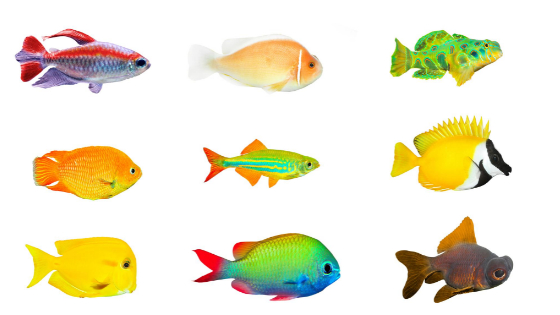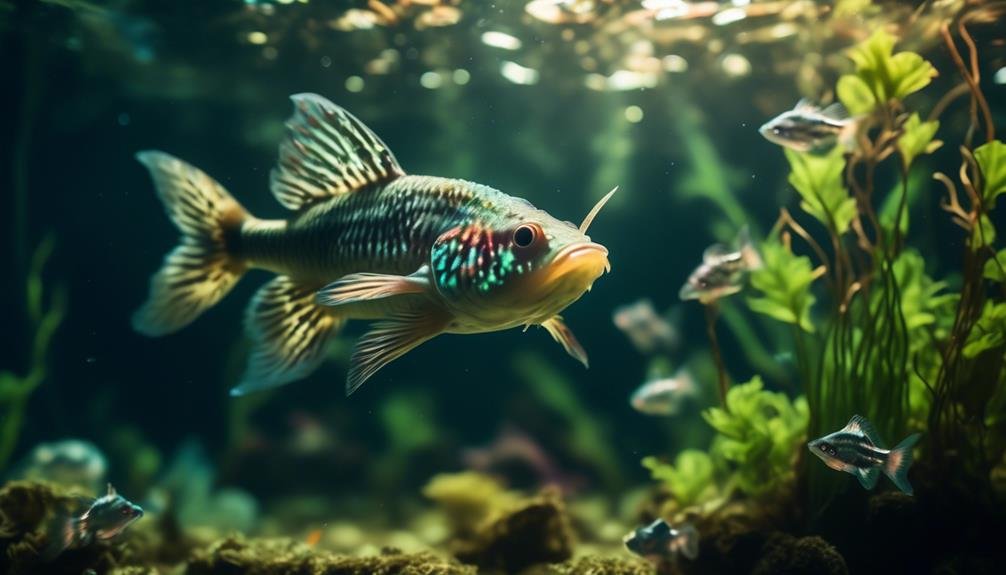
Have you ever wondered why Corydoras catfish are considered so fascinating?
It’s been said that these unique creatures possess secret abilities that set them apart from other fish.
As you begin to explore the world of Corydoras catfish, you’ll soon realize that there is much more to these captivating creatures than meets the eye.
So, let’s dive in and uncover the intriguing secrets of their behavior, their interactions with other fish, and the fascinating adaptations that make them such an enchanting addition to any aquarium.
Key Takeaways
- Corydoras catfish are docile and suitable for community tanks, making them a great addition to any aquarium.
- They prefer a freshwater environment with warm, slightly acidic water and a pH between 6.0 and 8.0.
- Corydoras catfish come in a variety of colors and patterns, adding visual interest to the tank.
- They are bottom-dwelling fish that do not eat live aquarium plants, but proper feeding is necessary to prevent plant damage.
Description and Origins
Corydoras catfish, also known as cories or cory catfish, are fascinating aquatic creatures that belong to the armored catfish family. These docile creatures are suitable for community tanks and display unique patterns and colors that make them visually appealing. It’s best to keep them in groups of six or more to ensure their well-being.
Corydoras catfish are commonly found in South America, inhabiting quiet, slow-moving waters with heavily planted or muddy bottoms. They can be found in small streams, marshlands, river margins, and ponds. These hardy creatures are adaptable to aquarium life and require a medium-sized freshwater environment. Weekly maintenance is necessary, and they’re compatible with other Corydoras, Gouramis, Characins, and Livebearers.
They prefer warm, slightly acidic water with a pH between 6.0 and 8.0 and water hardness between 5 and 19 dGH. It’s important to provide them with hiding places in planted tanks and avoid high nitrate levels and hard substrate to protect their barbels. Corydoras catfish come in a variety of colors and patterns, with some exhibiting black, gray, or brown coloration, while others have spots or bars on their bodies and fins. Albino variations are also available, adding to their visual appeal. They can blend in with the bottom layers or have standout color patterns.
In a planted tank, they can coexist with live plants without causing any harm. Other suitable tankmates for Corydoras catfish include Livebearers, Gouramis, Rasboras, and Tetras. Livebearers like Guppies, mollies, platies, and swordtails are suitable for planted tanks as they’re unlikely to eat live plants. Gouramis, such as the Blue gourami, dwarf gourami, and three-spot gourami, show little interest in live aquarium plants and add vibrancy to the tank with their vibrant colors.
Rasboras create a stunning visual effect when schooling among aquarium plants and are known for their vibrant colors. Tetras, which come in a variety of species with bright colors, are suitable for both beginners and experienced aquarists.
When it comes to specific care, Corydoras catfish are bottom-dwelling fish that don’t eat live aquarium plants but may use them for breeding. They’ve a peaceful nature and unique looks, with various species exhibiting different patterns and colors. While they don’t eat plants, proper feeding is necessary to prevent any plant damage.
Aquarium Requirements and Maintenance
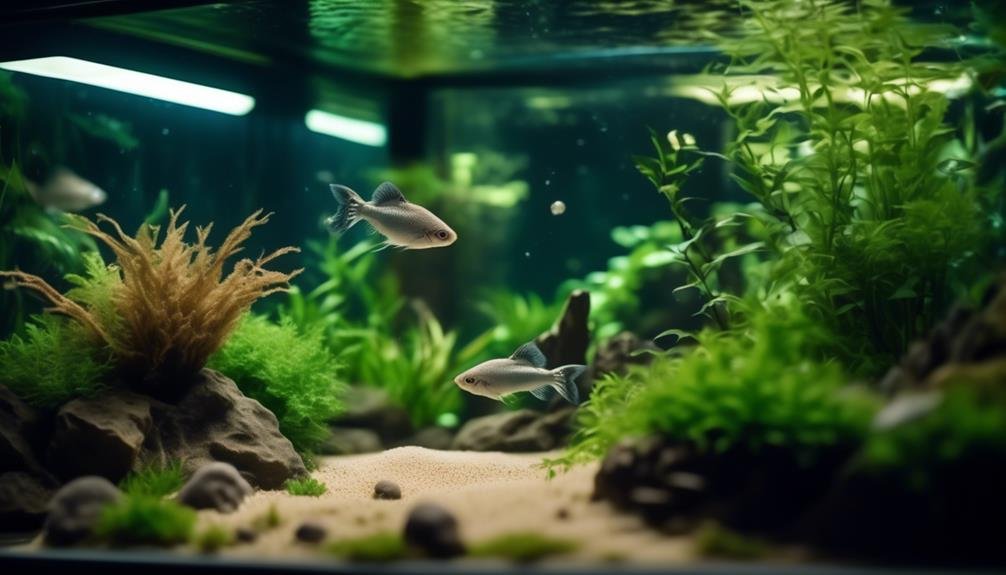
To maintain a healthy and vibrant environment for your Corydoras catfish, it’s important to ensure that your aquarium meets their specific requirements and that regular maintenance is performed. Here are four essential factors to consider:
- Aquarium size: A medium-sized aquarium is suitable for Corydoras catfish. Make sure it provides enough space for them to swim and explore.
- Water conditions: Corydoras catfish prefer a freshwater environment with slightly acidic water. Maintain a pH between 6.0 and 8.0, water hardness between 5 and 19 dGH, and a temperature range between 68F and 82F.
- Tank setup: Provide hiding places and a heavily planted tank for Corydoras catfish to feel secure. Avoid hard substrate and high nitrate levels to protect their delicate barbels.
- Regular maintenance: Perform weekly water changes and clean the tank to ensure optimal water quality. Regularly check the filtration system and monitor temperature and pH levels.
Color Variations
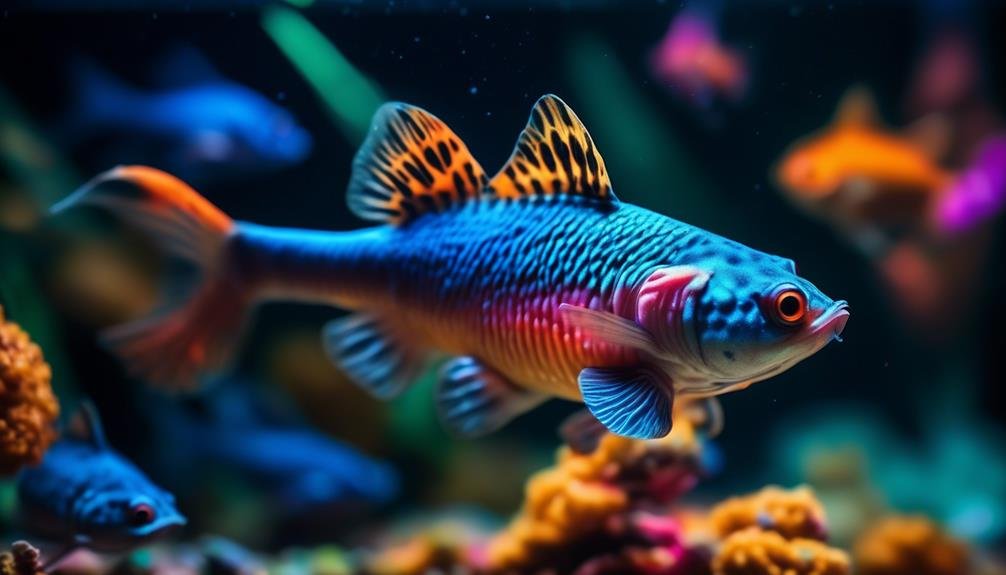
The Corydoras catfish exhibit a fascinating array of colors and patterns. These unique colors and patterns make them a popular choice among aquarium enthusiasts. Below is a table showcasing some of the different color variations you can find in Corydoras catfish:
| Color Variation | Description | Example Species |
|---|---|---|
| Albino | White or pale pink body with red eyes | Corydoras paleatus |
| Leopard | Spots or blotches resembling a leopard’s coat | Corydoras julii |
| Panda | Black body with white patches | Corydoras panda |
These are just a few examples of the many color variations that can be found in Corydoras catfish. Whether you prefer a vibrant and eye-catching fish or a more subtle and camouflaged one, there is a color variation to suit your taste.
Livebearers, Gouramis, Rasboras, and Tetras
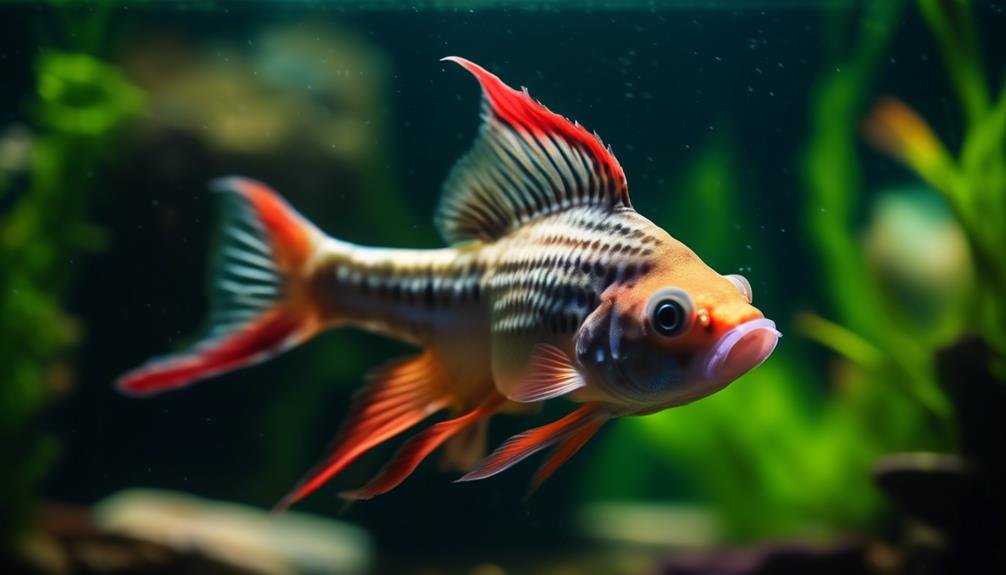
Now let’s explore the fascinating world of Livebearers, Gouramis, Rasboras, and Tetras, and how they can complement the vibrant colors and patterns of Corydoras catfish in your aquarium.
- Livebearers such as Guppies, mollies, platies, and swordtails are suitable for planted tanks. They won’t eat live plants and add a lively presence to your aquarium.
- Gouramis, including the Blue gourami, dwarf gourami, and three-spot gourami, show little interest in live aquarium plants. Their vibrant colors make them visually captivating additions to your tank.
- Rasboras create a stunning visual effect when schooling among aquarium plants. These colorful and vibrant fish are sure to catch your eye.
- Tetras, suitable for both beginners and experienced aquarists, come in a variety of species with bright colors. They add a lively and dynamic element to your aquarium.
With these fascinating fish alongside your Corydoras catfish, your aquarium will be a vibrant and captivating underwater world.
Corydoras Specific Care
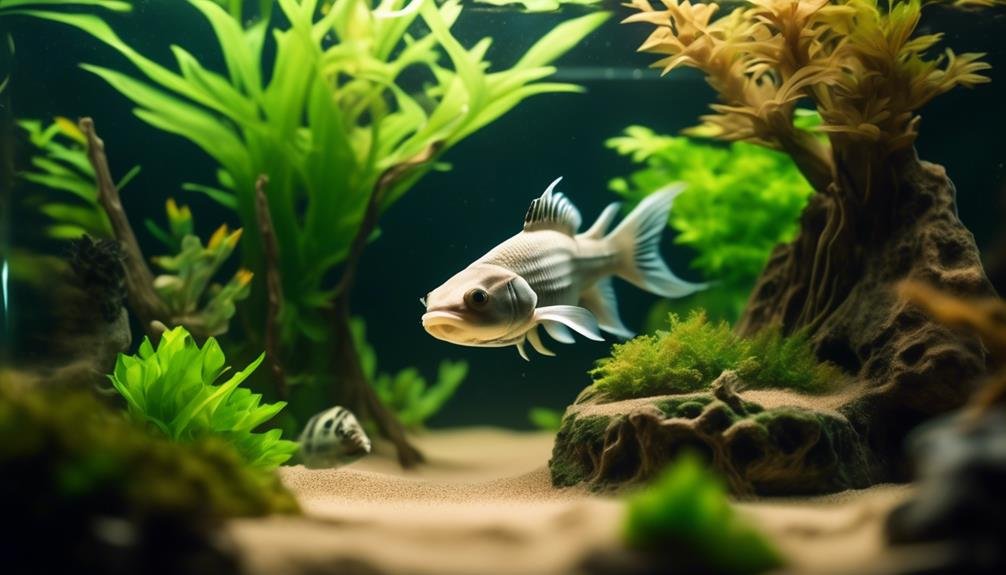
When caring for Corydoras catfish, it’s important to provide them with the proper environment and diet to ensure their well-being. These bottom-dwelling fish have a peaceful nature and unique looks, coming in various species with different patterns and colors.
While they don’t eat live aquarium plants, it’s still necessary to provide them with proper feeding to prevent plant damage. Corydoras catfish aren’t picky eaters and will readily accept a variety of foods, including sinking pellets, flakes, and frozen or live foods such as brine shrimp or bloodworms. It’s important to feed them a balanced diet to promote their overall health.
Additionally, maintaining a clean and well-maintained aquarium with suitable hiding places and a sandy or soft substrate will help create a comfortable environment for these fascinating fish.
Behavior and Temperament
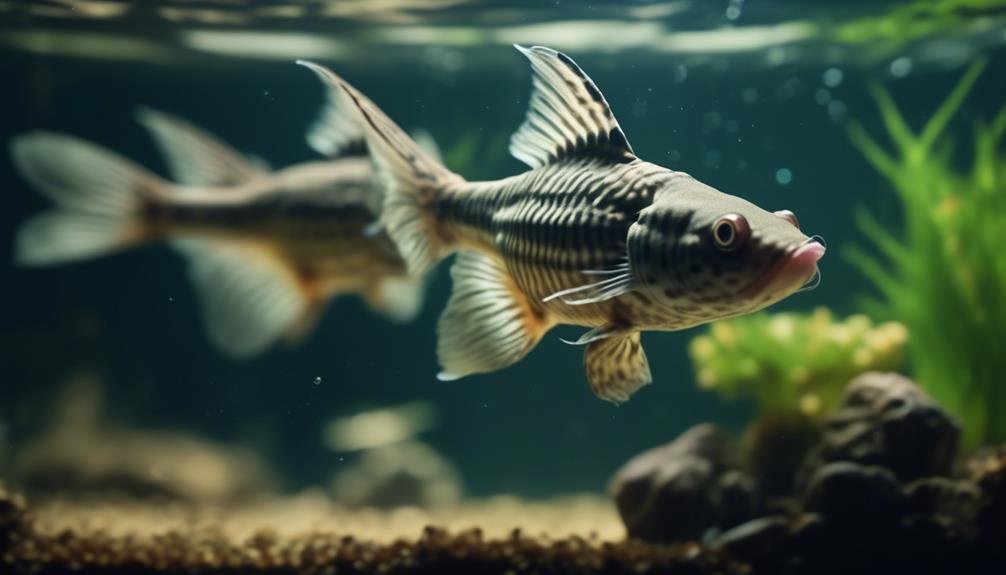
Corydoras catfish exhibit fascinating behavior and a peaceful temperament that make them a delightful addition to any aquarium. Here are four key things to know about their behavior and temperament:
- Social creatures: Corydoras catfish are highly social and thrive when kept in groups of six or more. They’re known to interact with each other, displaying playful behavior and forming tight-knit bonds.
- Bottom-dwellers: These catfish are primarily bottom-dwelling fish, scavenging for food on the aquarium floor. They use their barbels, sensitive sensory organs, to locate food and navigate their surroundings.
- Peaceful demeanor: Corydoras catfish are known for their peaceful nature. They rarely show aggression towards other fish species and are suitable for community tanks with compatible tank mates.
- Unique behaviors: Corydoras catfish display fascinating behaviors, such as ‘tumbling,’ where they roll on their sides to clean their bodies, and ‘popping,’ where they quickly shoot up to the water’s surface for a gulp of air.
With their captivating behavior and gentle disposition, Corydoras catfish bring an enchanting charm to any aquarium setting.
Breeding and Reproduction
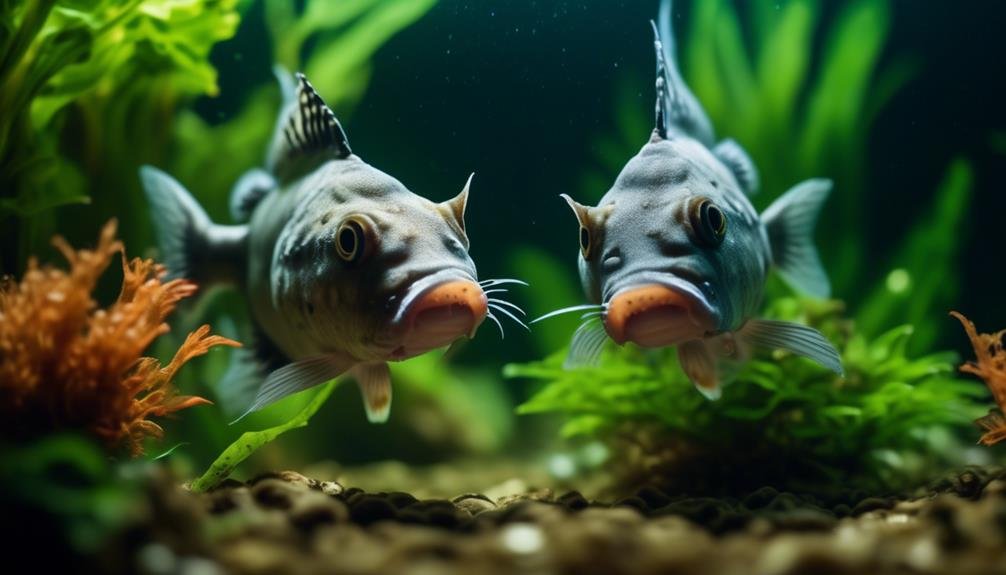
After observing the fascinating behavior and peaceful nature of Corydoras catfish, it’s natural to wonder about their breeding and reproduction habits. Corydoras catfish are known for their unique breeding behaviors and interesting reproductive strategies. Here is a table summarizing some key aspects of their breeding habits:
| Breeding Habits | Description |
|---|---|
| Spawning | Corydoras catfish are egg layers and typically spawn in pairs or small groups. The male will chase and nudge the female, encouraging her to lay eggs. |
| Egg Depositing | The female will lay her eggs on a flat surface, such as a plant leaf or a smooth rock. The eggs are adhesive and will stick to the chosen surface. |
| Parental Care | After the eggs are laid, the male will fertilize them. Both parents will actively guard and protect the eggs from potential threats. They will fan the eggs with their fins to provide oxygen and prevent fungal growth. Once the eggs hatch, the parents will continue to protect the fry and guide them to food sources. |
Understanding the breeding and reproduction habits of Corydoras catfish can enhance your appreciation for these fascinating and unique fish.
Feeding and Diet
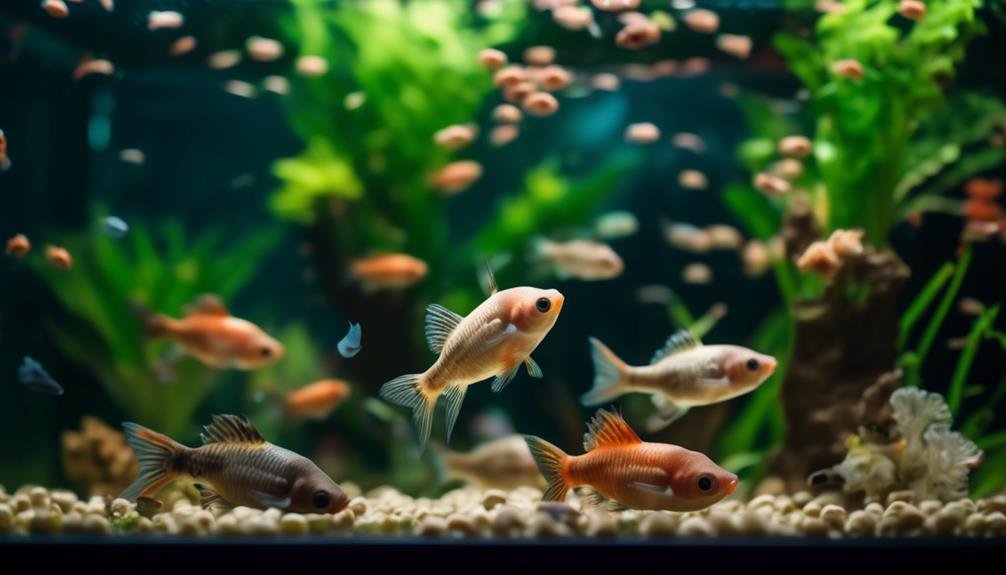
To properly care for Corydoras catfish, it’s important to understand their feeding and diet requirements. Here are four key points to consider:
- Omnivorous Diet: Corydoras catfish are omnivores, which means they eat both plant and animal matter. Provide them with a balanced diet that includes high-quality sinking pellets or flakes, as well as live or frozen foods like bloodworms, brine shrimp, and daphnia.
- Small and Frequent Feedings: These catfish have small mouths, so it’s best to feed them small amounts of food multiple times a day. This mimics their natural feeding behavior and prevents overeating and waste buildup in the aquarium.
- Variety is Key: Offer a variety of foods to ensure they receive all the necessary nutrients. Mix up their diet with different types of pellets, flakes, and live or frozen foods. This will also keep them mentally stimulated and engaged during feeding time.
- Supplement with Vegetables: In addition to protein-rich foods, include some vegetable matter in their diet. Blanched vegetables like zucchini, cucumber, and spinach can be offered as treats. These help to supplement their diet and provide essential fiber.
Common Health Issues
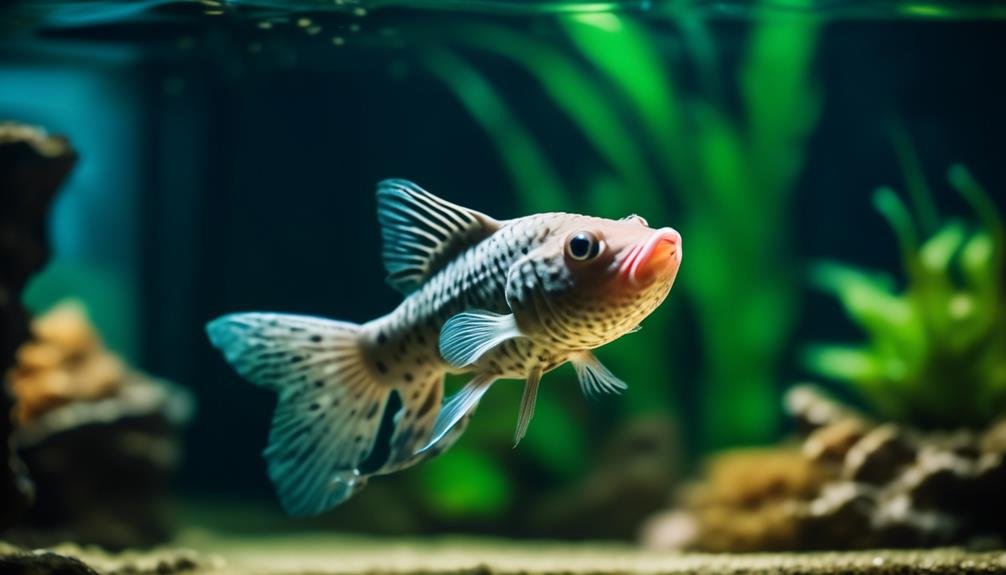
When caring for Corydoras catfish, it’s important to be aware of common health issues that may arise. These catfish are generally hardy and adaptable, but like any other fish, they can still experience health problems.
One common issue is the development of fin rot, which is characterized by the deterioration of the fish’s fins. This can be caused by poor water quality or bacterial infections.
Another health concern is the presence of parasites, such as Ich, which can cause white spots on the fish’s body and fins.
Additionally, Corydoras catfish are susceptible to swim bladder disease, which affects their ability to swim properly.
To prevent these health issues, it’s crucial to maintain good water quality, provide a balanced diet, and promptly address any signs of illness.
Tips for Creating an Ideal Habitat
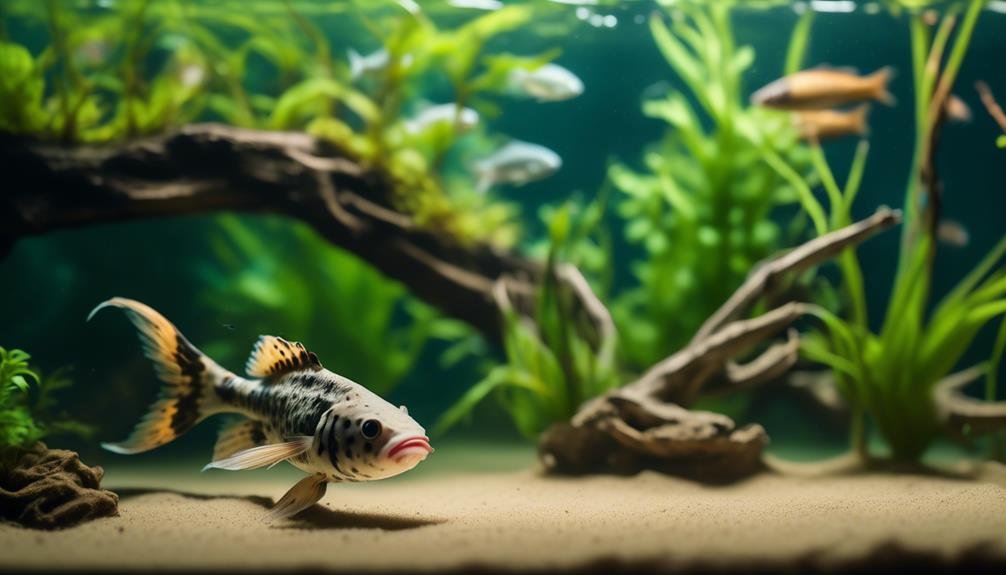
Creating an ideal habitat for Corydoras catfish involves ensuring proper tank conditions and providing suitable hiding places for these bottom-dwelling fish. Here are some tips to help you create the perfect environment for your Corydoras catfish:
- Tank size: A medium-sized aquarium is suitable for Corydoras catfish. Make sure the tank has enough space for them to swim comfortably.
- Water parameters: Corydoras catfish prefer warm, slightly acidic water. Maintain a pH between 6.0 and 8.0 and a water hardness between 5 and 19 dGH. Keep the temperature between 68F and 82F.
- Substrate and plants: Use a soft substrate to protect their delicate barbels. Corydoras catfish love hiding, so provide plenty of hiding places using plants, caves, and driftwood.
- Tank mates: Corydoras catfish are peaceful and can be kept with other compatible fish like Gouramis, Characins, and Livebearers. Make sure to choose tank mates that won’t harm or outcompete them for food.
Follow these tips, and your Corydoras catfish will thrive in their new habitat.
Popular Corydoras Species for Beginners
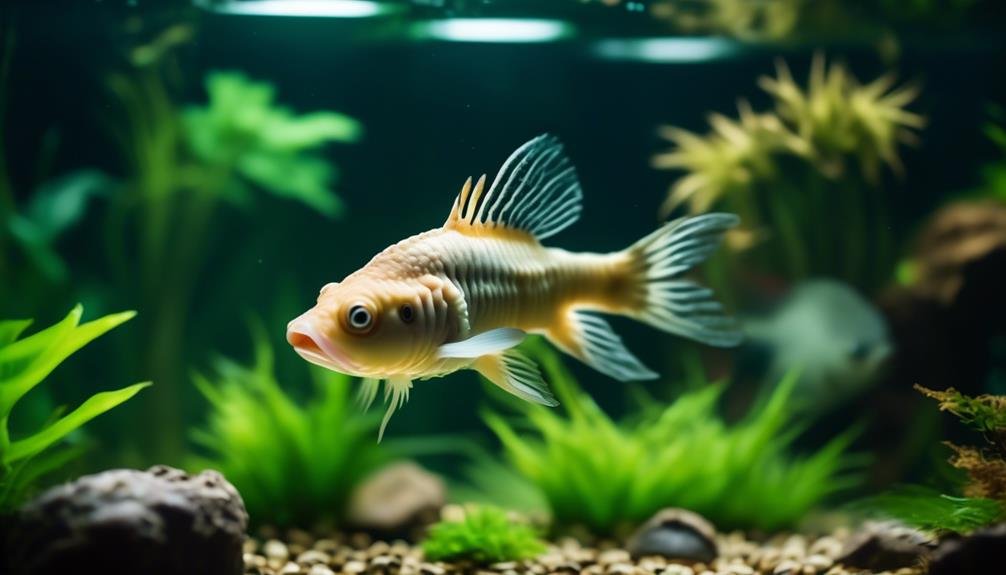
If you’re a beginner looking to add some Corydoras catfish to your aquarium, there are several popular species that are perfect for you.
One such species is the Bronze Corydoras (Corydoras aeneus), which is known for its peaceful nature and hardiness. They’ve a bronze-colored body with a pale belly and can grow up to 2.5 inches in length.
Another popular choice is the Peppered Corydoras (Corydoras paleatus), which has a silver body with black speckles and a white belly. They’re also peaceful and can grow up to 2.5 inches long.
Lastly, the Albino Corydoras (Corydoras aeneus) is a great option for beginners. They’ve a pale pinkish-white body and red eyes, adding a unique touch to your aquarium.
These species are all easy to care for and make a great addition to any beginner’s tank.
Frequently Asked Questions
What Is the Lifespan of Corydoras Catfish?
The lifespan of Corydoras catfish varies depending on the species, but generally, they can live for about 5 to 10 years in proper care. Providing a suitable environment and balanced diet is crucial for their longevity.
Can Corydoras Catfish Be Kept With Aggressive Fish?
Yes, corydoras catfish can be kept with aggressive fish, but it’s important to choose tankmates carefully. Opt for peaceful species that won’t harm or stress the corydoras. Provide plenty of hiding places to promote a harmonious aquarium environment.
Do Corydoras Catfish Need a Sand Substrate?
No, Corydoras catfish don’t need a sand substrate. They prefer a heavily planted or muddy bottom. Sand is not necessary, but make sure to avoid hard substrates to protect their barbels.
How Often Should Corydoras Catfish Be Fed?
Corydoras catfish should be fed once or twice a day with small amounts of high-quality sinking pellets or frozen foods. Avoid overfeeding to prevent water quality issues and obesity.
Are Corydoras Catfish Prone to Any Specific Diseases?
Corydoras catfish are generally hardy and adaptable, but like any fish, they can be prone to certain diseases. It’s important to maintain good water quality, provide a balanced diet, and monitor their health regularly to prevent any potential issues.
Are Corydoras Catfish Different from Other Types of Catfish?
Corydoras catfish are indeed different from other types of catfish in the fascinating world of catfish. They are known for their peaceful nature and social behavior, making them popular choices for community aquariums. Their unique appearance and behavior set them apart from other catfish species.
Conclusion
In conclusion, the world of Corydoras catfish is truly fascinating. These docile and colorful creatures make a stunning addition to any aquarium. By providing the right care and environment, you can ensure their health and happiness.
With their compatibility with other popular fish species, they can create a harmonious community tank. So, dive into the world of Corydoras catfish and add a touch of wonder to your aquarium.




